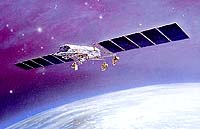| . |  |
. |
RIA Novosti military commentator Moscow, Russia (RIA Novosti) Jan 18, 2010 The U.S. media suspects China and India of developing anti-satellite weapons. An article to this effect has been published the New Scientist magazine. Until recently, only the Soviet Union, its legal successor Russia and the United States were capable of developing anti-satellite weapons. U.S. analysts now think that China and India are acquiring similar capabilities. To what extent are such fears justified? It is hard to overestimate the role played by military satellite systems. Since the 1970s, an increasingly greater number of troop-control, telecommunications, target-acquisition, navigation and other processes depend on spacecraft which are therefore becoming more important. At this point, it is impossible to imagine the armed forces of most industrial states, including Russia, without combat-ready satellite clusters comprising spacecraft of various types. The space echelon's role is directly proportional to the development level of any given nation and its armed forces. However, satellite clusters are hardly invulnerable. Ever since the U.S.S.R. and the United States launched their first military satellites, efforts have been made to develop anti-satellite systems. Such efforts were intensified after the creation of initial missile defense systems comprising the highly important space echelon. Orbital satellite interceptors, surface-to-space and air-to-space missiles were eventually developed. Research aiming to develop orbital and ground-based anti-satellite laser guns making it possible to either destroy spacecraft or knock out their electronics and optical devices deserves special mention. However, few results have been achieved in this area. China, which claims the right to be a global power, prioritizes the development of anti-satellite weapons. A 2007 Chinese anti-satellite missile test was conducted at 10.26 p.m. Greenwich Mean Time (GMT) on January 11, 2007 or at 6.26 a.m. Beijing time on January 12. A Chinese weather satellite - the FY-1C polar orbit satellite of the Fengyun series, flying at an altitude of 865 kilometers (537 mi) - was destroyed by a kinetic kill vehicle traveling at a speed of 8 km/second in the opposite direction. Although the exact name of the missile is not known, sources mentioned a KT-1/SC-19 system described as being based on a modified DF-21 medium-range ballistic missile or its commercial derivative, the KT-2, with a kinetic kill vehicle mounted. The 11-meter DF-21 missile weighs 15 metric tons. The above referenced kinetic kill vehicle destroyed the satellite with a direct hit. China thus became the second nation in history to conduct practical anti-satellite system tests. On September 13, 1985, the United States destroyed U.S. satellite P78-1 using an ASM-135 ASAT anti-satellite missile launched from an F-15 Eagle air superiority fighter. A malfunctioning U.S. spy satellite USA-193 was destroyed by a RIM-161 Standard Missile 3 on February 21, 2008. The Chinese anti-satellite weapons test highlighted Beijing's ability to fight a space war if necessary, and caused a nervous response primarily on the part of Japan and the United States. It is common knowledge that China continues to develop anti-satellite weapons and to create new versions of missile interceptors. Although there is hardly any convincing evidence regarding possible Indian efforts to develop similar weapons, the country's Defence Research and Development Organisation (DRDO) has voiced its intention to create a satellite interceptor. If this statement is true, New Delhi plans to copy the Soviet example. As is known, Moscow had developed various types of orbital anti-satellite weapons, including the 80-ton Skif-DM battle station that was to have been launched by the super-heavy Energia space rocket. It is unclear how fast India will be able to develop an anti-satellite weapon and to orbit it. This project will probably take many years to implement. At the same time, India could develop a missile interceptor based on medium-range ballistic missiles to knock down satellites the way China did. More countries will acquire anti-satellite capabilities in the future. Technically speaking, all countries wielding their own ballistic missiles, including Iran and North Korea, have the potential. It is still hard to predict the influence of such programs on the subsequent development of military space systems. The opinions expressed in this article are the author's and do not necessarily represent those of RIA Novosti.
Source: RIA Novosti
Share This Article With Planet Earth
Related Links - Military Space News at SpaceWar.com
 USAF And LockMart Complete Environmental Testing Of Missile Warning Satellite
USAF And LockMart Complete Environmental Testing Of Missile Warning SatelliteSunnyvale CA (SPX) Dec 03, 2009 The joint U.S. Air Force/Lockheed Martin-led team announced that it has successfully completed thermal vacuum testing of the first Space Based Infrared System (SBIRS) geosynchronous (GEO-1) satellite, one of the most significant program milestones that validates spacecraft performance in a simulated space environment. The U.S. Air Force's SBIRS program is designed to provide early warning ... read more |
|
| The content herein, unless otherwise known to be public domain, are Copyright 1995-2009 - SpaceDaily. AFP and UPI Wire Stories are copyright Agence France-Presse and United Press International. ESA Portal Reports are copyright European Space Agency. All NASA sourced material is public domain. Additional copyrights may apply in whole or part to other bona fide parties. Advertising does not imply endorsement,agreement or approval of any opinions, statements or information provided by SpaceDaily on any Web page published or hosted by SpaceDaily. Privacy Statement |